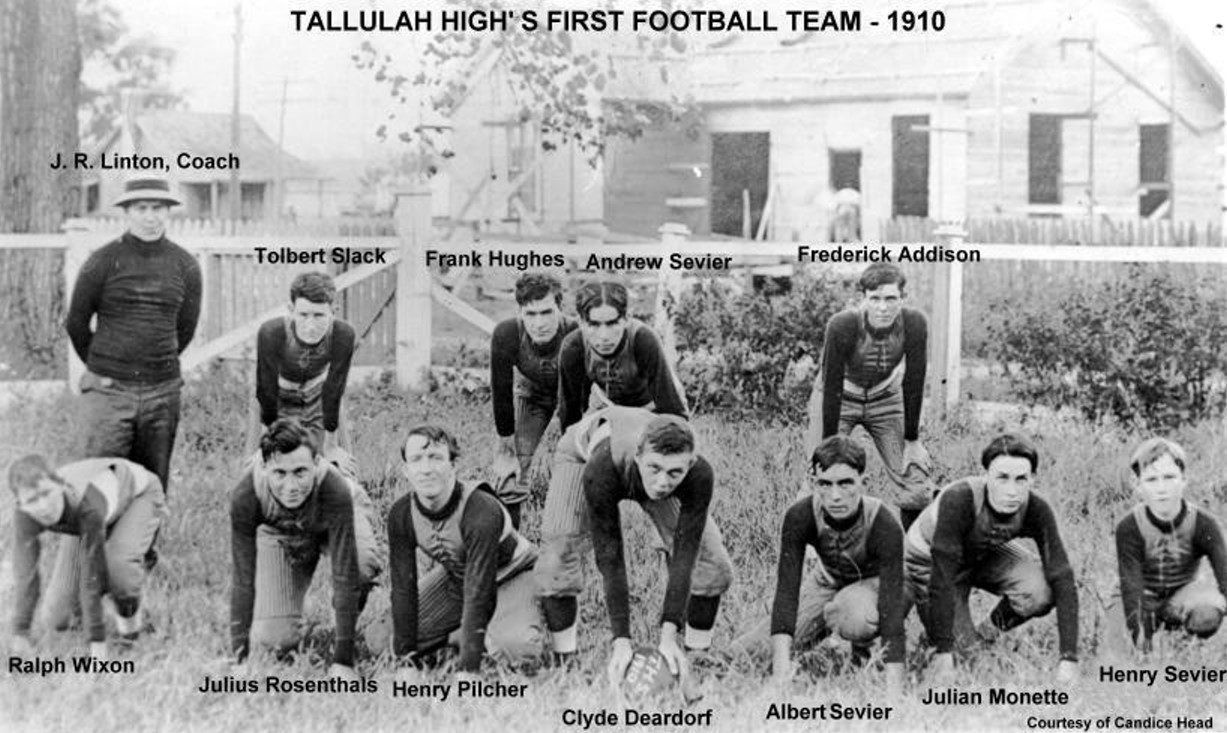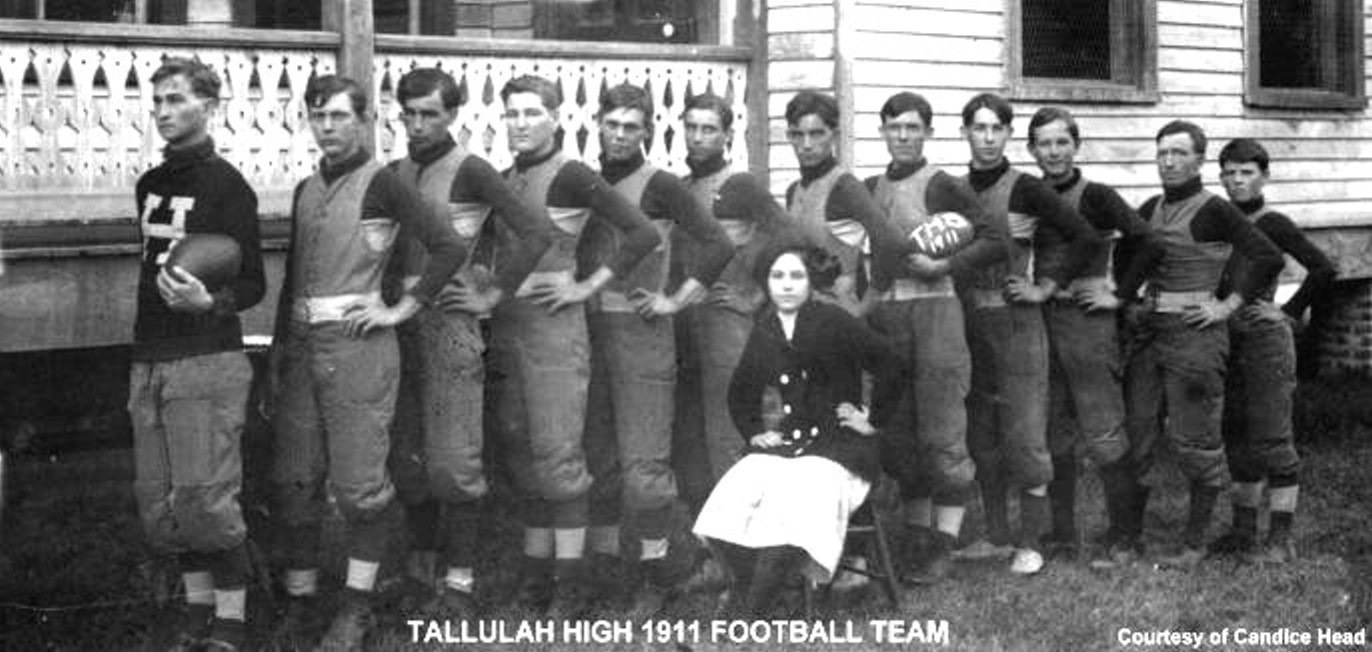Early History of THS Football
Modified from August 14, 1975 Centennial Edition Madison Journal
The history of football in Tallulah began in 1910. It had
humble origins and received scant attention.
Few people in this sleepy little Delta town knew anything
about the sport. But what began the first year, 1910, when James R.
Linton fielded a team, grew rapidly into a way of life for the people of
this area. They loved the game.

From football's inception in Tallulah to the present, the
people have supported their teams through good times and bad. It might tritely
be called "a way of life" but that's the way it is. And if you don't
believe Tallulahians love the game, just ask them.
They'll tell you. But how did it all get started?
Linton was recruited to Tallulah for a coaching-teaching
position at Tallulah High School. A native of Steubenville, Ohio, he was a
graduate of Hiram College.
Prior to his arrival, Linton had been recommended by a
Hiram College professor to C.M. Hughes, principal of Bunkie High School, who
had been looking for a football coach. The young man had starred on the Hiram
football team where he played center, guard and tackle, giving him the
credentials Bunkie High hoped to find.
Hughes accepted the position of principal at Tallulah
High in 1910 and brought Linton with him as a teacher and coach. Shortly after
their arrival, Linton organized Tallulah's first football team. Asked about
those early days, Linton said: "There weren't enough players for two full
teams to practice so I pulled half of the line over to the other side so we
could have contact.
"We practiced in the afternoon after school over
across the Missouri Pacific Railroad and I don't recall who owned the land,
however, it was not school property."
"The boys wore uniforms somewhat similar to those
today. The pants were well-padded with padded vest over a turtleneck
sweatshirt. There were no helmets or face guards, though we did make the boys
wear rubber mouth pieces.
"Members of the first football team were right end,
Ralph Wixon; right tackle, Wayne Peek; right guard,
Henry Pilcher; center, Clyde Deardorff;
left guard, Albert
Sevier; left tackle, Julian Monette: left end, Henry
Sevier; right halfback, Tolbert Slack; fullback. Frank
Hughes; left halfback. Frederick Addison; and quarterback Andrew
L. Sevier.
"The small schools in our area and a lack of boys
made it difficult getting up a team, therefore, each team was allowed one
ineligible player. The coaches were also permitted to play and referees were
chosen by agreement between the two coaches but were always someone from a
third town.
"Positions were much the same as they are today but
a team had three downs to make five yards for a first down on an unmarked
field.
"Schedules of the games were not made in advance and
few schools in our area had teams. Those that we played were Lake Providence,
which was our biggest rival, St. Aloysius in Vicksburg, and a school south of
Delhi called Central coached by Claire Chennault, and Delhi. We traveled to the
games on the train.

Linton recalls a train trip to Lake Providence for a
game. On the train the Tallulah team met two L.S.U. football players who were
going to Lake Providence. Much to the surprise of the Tallulah team, when they
lined up on the field, the two players were playing with the Lake Providence
team.
At the game, the referee made a decision Linton didn't
like and the Tallulah mentor went out on the field. The referee said he had no
right to be there and Judge Ransdell, a spectator,
threatened to put him in jail. Lake Providence won the game.
The details of the years following Linton's arrival and
the first two seasons aren't exactly clear.
Some of the football players of the era disagree as to
who coached and when but most contend there were no football teams from
1913-1920 and Tallulah's exact win-loss records are not certain until 1930.
J.W. Noblett coached in the 1913 season and
apparently football resumed in the fall of 1921.
Adams remembers...
"R.R. Jemison coached football in 1921. From 1913-1920
there were basketball and baseball teams but not football. There weren't
enough big boys to field a team," 1922 graduate W.Z. (Bill)
Adams said. "Football started gaining momentum with Knute Rockne and the 'Four-Horsemen' at Notre Dame. My
brother Ed
Adams took a football to school and a bunch of boys got a hold of it and
decided to start another team. All the players got their mothers to make them
uniforms which resembled T-shirts stuffed with cotton padding.
"The 1921 team was composed of: Cail
Day, George
Jordan, Leonard Alexander, Jack Coltharp, J.P.
Jones, Floyd Hynum, George
Spinks, Billy
Craig, Charles Van Dine, Bill Adams, Hugh
Montgomery, Frank
Montgomery, Charles Montgomery, and Man Kell.
"The town hired some of the players to run the light
plant and play football. Anybody in town who knew the rules refereed the games.
The Coach was paid by subscription from the town folks.
"A couple of the players on the '21' team went to
college but none of them played college ball. Leonard Alexander went to Tulane
or Mississippi State and think he's a professor in Indiana now," Adams
said.
Spinks recalls...
George Spinks, a 1922 Tallulah High graduate remembers
the 1923 fight between the Rayville and Tallulah teams.
Spinks said the fight started when time ran out but S.L.
Chapman, the timekeeper didn't stop the game because he wanted to see if
Tallulah, who was way out in front, could score again.
One of the Hunnicut brothers from Rayville found out
about it, "lowered the boom" on Chapman, and all the Hunnicuts got in on the action.
"The field was 100 yards long and people were
fighting from goal post to goal post.
"One of the player's mothers was a dedicated fan and
would go out on the field and rough up the referee or players on the other team
if she didn't like a decision. The game was much more unrestrained back in
those days, Spinks said.
In 1923, B.C. Banks became coach and brought in
"hired players" from Clemson where he had been an All-Southern
quarterback.
"One of the 'hired players' named Prickett could kick as well as anybody in the SEC,"
1926 THS graduate Don
Sevier said.
"The 'hired' team had trouble scheduling games. In
one practice scrimmage with Vicksburg several of their players were broken up
and hurt" Sevier said.
"We played more of a single wing formation which was
used successfully by the University of Tennessee for many years.”
Sevier said when J.D. Williamson took over as coach,
football at THS became more organized and on the up and-up.
Ziegler states. . .
W.W.
Ziegler said he first began playing football as a seventh-grader in 1922.
This was the year of the hired team that played Hinds Junior College and big
Jackson, Mississippi Central in 1923.
In 1922, some of the players were Bell Runnells, Monk
McCoy, Bill
Oakes, Douglas Faulkner, J.P. Jones, Hugh Montgomery, "Bull"
Johnson, Richard Alexander, Chalmer Bridge, Bruce Carter and Alton McCready, according to Ziegler.
The backfield for the 1924-25, teams he said, was Don
Sevier, quarterback; Gaines Abernathy, fullback; Kenson
Vance, right halfback; and himself at left halfback.
In 1926, Ziegler said Tallulah won several games with Dean Allen
at end; Tilman Bankston,
end; William McCready, tackle; J.T. Roy,
Tackle; Jack
Bethea, guard; Jack
Motley, guard; and line Wiley Motley and Melvin Riser.
"We played the state Class B Champions and finally
lost 18-6 but hung in there pretty good until the end
of the game."
Judge Adams says...
Judge Cliff
Adams played for Coach Williamson on the 1928
football team. Adams played center and said he weighed in at about 155
pounds.
1928, according to Adams, was the first year the team
went by the name "Trojans" and the football players received letter
sweaters.
"The lettermen sweaters were blue with a gold T on
the front. The top of the T was the word 'football', down the staff of the T
was the word 'Trojan', and '1928' was written at the base of the T", the
judge said.
"Adrian
Willett suggested the name of Trojans after the USC Trojans in California
and the students decided it was the right name.
"The class ring of '29' had a picture of a gladiator
and shield drawn by Colyer Weathersby.
"I can't remember the scores of the games but I
believe we played Ferriday, Rayville, St. Aloysius of
Vicksburg, Crowville, and Forest.
"We lost one game on a trick play. The other team
called time out and then called time in before we could get in position. The
players were lying down behind their positions and suddenly sprang into action
when time was called. The center snapped the ball and they ran a touchdown.
"Every school had a trick play they would caution
the referee to watch for so he could be aware of what was going on," Adams
said.